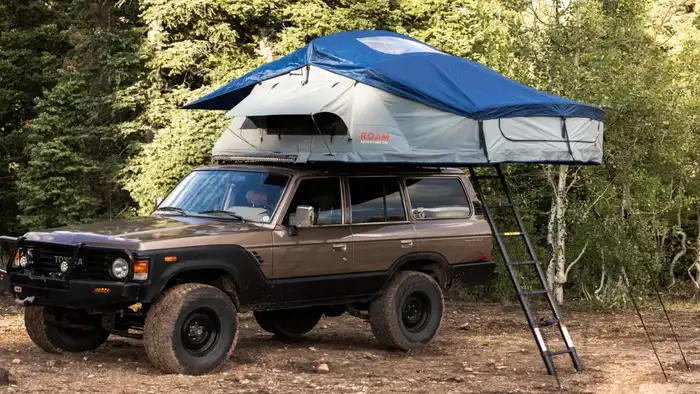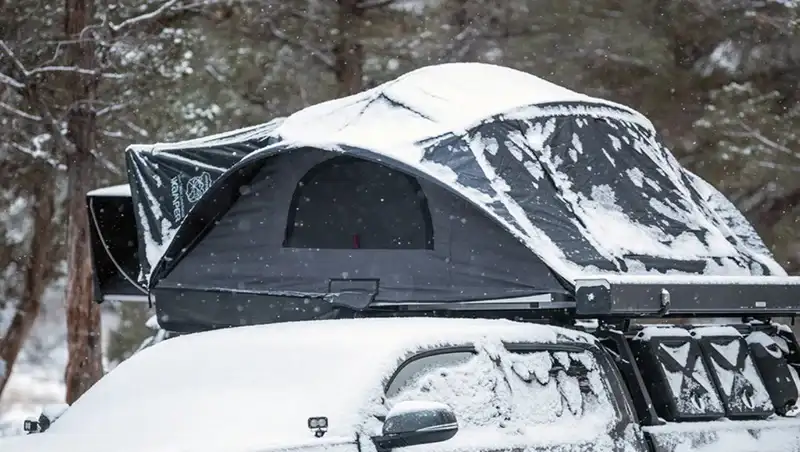Both rooftop tents and ground tents have their advantages and disadvantages, but when it comes to warmth, which one is better? I think I have an answer, so keep reading.
There is no doubt that, when it comes to warmth, rooftop tents have an advantage over ground tents. There are several reasons for that, and they include:
- Elevated position of a roof top tent.
- Insulation.
- Thicker and stronger fabric.
Elevated position
When you are in a rooftop tent, you are raised off the ground. The top picture above shows the iKamper X-Cover 2.0 roof top tent in a winter environment, and it is on a truck far above the ground.
You probably know that it can be colder closer to the ground during the night. Perhaps you have experienced it, there may be frost on the ground although your thermometer tells you that the air temperature is not at a freezing level.
But this is not so during a sunny day, just to know. So you may be warmer closer to the ground. This is fine if you are using a rooftop tent because you will likely not spend your day time on the roof of your car.
Insulation of rooftop tents
There are a few separate things to mention here related to insulation.
Mattress
The term insulation may imply a mattress. So in rooftop tents, you always have an open-cell foam mattress included. Such mattresses are usually in the range 2-3 inches, so this is an insulating layer that protects you from below.
Rooftop tents’ brands practically never mention the R-value of such a mattress, but you can expect that it usually quite high. Just in case you are not familiar with this, with an R-value above 4 or 5, such a mattress is good enough for any weather.
On the other hand, when you deal with foam pads built for ground tents, this R-value is usually mentioned. So the higher R value the better. I have one self-inflating type, the DoD Soto sleeping pad, with the R-value 8.3, and I am sure it can be used even on the snow and I would be perfectly safe.
But ground tents do not come with a pad included. So it is up to you to choose one that will protect you from the cold ground. In fact, for such outdoor sleeping, the pad is the most important part of your equipment.
Integrated insulation in the tent itself
In the case of hard shell rooftop tents, you have a solid bottom and a solid lid. Usually, both have an integrated insulation. This holds for both pop-up type and clamshell rooftop tents.
In the case of soft-shell roof top tents, you can have the bottom insulated. The picture below shows the Roam Adventure Vagabond XL Rooftop Tent where you have the platform made of have two layers of aluminum with an insulation sandwiched in between.

So imagine, you have two big parts of the tent insulated (in the case of hard shell tents), or at least the bottom (in the soft shell type).
There is nothing like that in ground tents. And you should know that you can lose 40-50 times more warmth to the ground than to the surrounding air if you sleep in a ground tent. So you have to rely on a sleeping pad only.
Accessory insulation
Many roof top tents’ brands offer accessory insulation. So if you know you will be camping in a very cold environment, you can order an insulating cocoon and attach it from inside.
But how is this with ground tents? Well, as of the moment of writing this text, ground tents with accessory insulation and indeed rare. There is one brand that is more or less globally present, that offers such insulation, and this is Crua Outdoors. They have insulation for all their ground tents, and also for rooftop tents.
Thicker fabric of rooftop tents
A roof top tent is transported on the vehicle, so you are not supposed to move it around in the camp. This is why the manufacturers can afford to use a heavier and thicker, and this means potentially warmer fabric.
Most of rooftop tents are made of a polycotton fabric. But there are many ground tents of that type of course.
However, some rooftop tents have walls made of a three-layer material. You can see great examples of that type in some tents of the Freespirit brand. The picture below shows their Freespirit Evolution rooftop tent which has a quilted construction.

There are winter camping ground tents built for Arctic expeditions that are built in the same style, but it is fair to say that these are extremely rare, and are they built for Arctic and Antarctic expeditions.
How about wind effects?
Roof top tents are notoriously non-aerodynamic. They are boxy and definitely not the best option for windy conditions. If you know that this will be a windy expedition, it is better not to count on a roof top tent.
On the other hand, there are low-profile ground tents built for such conditions, with a full fly that goes to the ground. Such tents perform far better in a windy environment and they can also better preserve warmth.
Final thoughts
In summary, this is about tents, so no matter how well they are built, if it is cold outside it will be cold inside as well. None of them is immune to cold weather. You will still need a good quality sleeping bag, and warm clothes to keep you comfortable.
But a tent can make a temperature difference that will be enough for you to survive, or even to feel reasonably comfortable. In general, rooftop tents are warmer than ground tents due to their elevated position and their usually far better insulation.
Let me know if you have questions, there is a comment box below. Check also my text about ventilation in rooftop tents. Thank you for reading and have a nice day.

 Hi, I am Jovo, the founder of this Off-Ground Tents site and several other outdoor sites. I have been mountaineering for almost 40 years already, and I have created this site to use as a reference for various types of above ground tents.
Hi, I am Jovo, the founder of this Off-Ground Tents site and several other outdoor sites. I have been mountaineering for almost 40 years already, and I have created this site to use as a reference for various types of above ground tents.